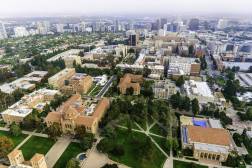Colleges are saying goodbye to old-school computer labs

Ten years ago, the role of the campus computer lab was clear-cut: Students needed computer access to do their schoolwork, and rooms lined with dozens of PC terminals were a common sight on every college campus. Today, demand for access to campus PCs is in decline, prompting higher ed IT leaders to question if it makes sense to keep them.
With heated competition for space on campus, changing demands from students, faculty and staff, tight budgets and limited staff, the campus computer lab of old just doesn’t make sense the way it used to, speakers said this month during an Educause webinar.
“[Previously] students needed computers, they needed access to computers, we provided them access to computers through the computer lab,” said Antony Awaida, CEO of virtual computer lab provider Apporto. “Increasingly, students have their own computers and to some extent they have a preference for using their own computers. So in this environment, what is the role of the computer lab?”
Eric Breese, associate CIO of the Illinois Institute of Technology, said during the event that his institution’s approach to computer labs has evolved significantly over the past decade. He said the institution’s nearly 1,000 PCs has dwindled to around 550 as it pursues a 100% remote model for its computer lab.
Breese said old-school computer labs are expensive and time-consuming to maintain because the hardware must be refreshed every few years. Space on campuses is limited, and many institutions have already invested in cloud technology and laptop loan programs to support the switch to remote labs, he said.
‘Remarkable what free pizza will do’
Before the COVID-19 pandemic, Illinois Tech surveyed its student body to understand how and why students used campus computer labs. The survey found that while students appreciated the labs, they liked them for different reasons, Breese said: Undergraduate students liked the collaborative space they provided, while graduate students just needed access to software they didn’t have at home.
Breese said the survey confirmed that traditional computer labs are no longer necessary to meet students’ needs. Students can bring their own devices to collaborative study spaces and virtual desktop software can provide access to specialized applications.
In another survey, students at Grand Valley State University reported similar sentiments, said the institution’s vice president for information technology and chief digital officer, Milos Topic.
“What we’ve discovered in recent years as we’ve engaged our faculty and students and listened to their needs — it’s remarkable what free pizza will do, hundreds of them show up and share their feedback — what they’re really looking for is reduced friction and increased flexibility,” Topic said. “They want greater access to the applications and software than to physical spaces themselves.”
‘Bring tools and technology to where people are’
Rather than shuttering its computer labs all at once, the Illinois Tech IT team decided which labs to continue updating and which labs to stop investing in, slowly repurposing the labs that lose favor with students and instructors, Breese said. Topic said Grand Valley State also began monitoring computer lab usage to understand where there’s demand.
“We started monitoring and looking at the usage of logins, application usage, licensing, servers, and everything else, and we realized that many of our labs are often below 40% capacity at peak times,” Topic said.
Through student surveys, Topic and his colleagues found that students wanted fast internet, big monitors to plug their laptops into, printer access and facilities open for late-night study sessions on campus, but they also wanted to be able to access the university’s software and applications from home. Now the institution is exploring how to make the most of virtual computing environments to maximize flexibility and “bring tools and technology to where people are — not have them have to come to us,” Topic said.
While some IT leaders are excited at the prospect of moving past old-school computer labs, challenges remain for institutions. Moving to cloud-hosted environments can be pricey and time-consuming and educating students about how to access them takes effort. Many audience members watching the Educause webinar reported that their institutions already offer virtual computer access, but it’s not widely used by students, faculty or staff outside of engineering departments.
One of the biggest hurdles to moving to a fully remote computer lab model for Illinois Tech is that certain software titles used in disciplines outside of computer science are “very hard to virtualize,” Breese said.
“It’s not a technical problem,” he said. “It’s getting certain vendors to understand that they’re operating in an environment from 20, 30 years ago.”




